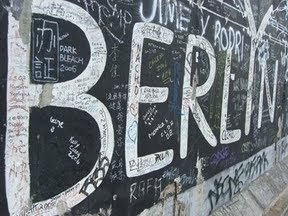Yesterday morning started with a 10:00 AM walking tour with Carol, an old friend of Janet's and an immensely knowledgeable guide. She took us on an amazing walk through Berlin showing us beautiful sites, making us aware of the architecture, and telling us the stories behind major buildings in Berlin. I've never been much of a historian -- dates and names have the tendency to go in one ear and out the other with me -- but what stood out to me throughout the day is just how differently Germans treat history.
Take, for example, the Reichstag, one of the German parliamentary buildings. Sitting atop the hall where parliament meets is a large transparent dome which houses a walkway to allow people to view the government in action. Anyone can register visit, and Carol told a story of a friend who celebrated her birthday with a picnic at the top.The dome serves as a constant reminder that governments should operate transparently, keeping the people involved and informed, and that in the past this has not been the case. Soviet graffiti on the walls of the Reichstag, left alone for years, serves as another powerful reminder of German history.
From there we travelled again to the Holocaust memorial for murdered Jews of Europe, a field of variously sized cement blocks that, viewed from a distance, give the impression of sarcophagi. As you walk through, the cement blocks become insurmountable barriers, making you feel trapped and insignificant. The narrow hallways make it impossible to see anything not directly in front of you, so you're forced to constantly look left and right, and are still left with no idea what might be lurking around every corner. It certainly gives one a good impression both of the scale of the horror and the feeling of helplessness felt by all the victims.
Soon after that we stopped outside the Topography of Terror outdoor exhibit, where the history of the Holocaust is displayed across an old prison wall beneath a remnant of the Berlin wall. The juxtaposition of these is a potent summation of some of the darkest moments in German history.
Later on, we stopped by a smaller memorial, three mirrors at angles to one another with a space in between with plaques telling the story of a Jewish designer. This small and inexpensive memorial incorporated into the daily lives of passing Germans (it's located outside of a subway station and can be used for last minute preening) shows that not all memorials have to be grand and expensive gestures.
All of these things made me very aware of how differently Germans treat history. They're not afraid to acknowledge the past as it was, or to accept that it IS relevant to us today. In American history classes we learn about things like slavery, the trail of tears, internment camps, censorship, and the civil rights movement as if they are just events that have come and gone, actions of our long dead barbarian ancestors that could not possibly have any bearing on our lives today. Germans look at history as something we have the obligation to remember and learn from, so that we continue to move forward. They don't learn detached names and dates, things that, for me and I'm sure many other students, have no real meaning and fly immediately from memory after completion of that scantron test. We learn about the use of slave labor from the beginning of our nation until the Civil war, and then the poor wages and conditions for African Americans afterwards, but we never connect that to the present issues of affirmative action or our treatment of immigrants, and so we're left with people who grow up thinking that Mexican immigrants are less than people, and that Muslims should be deported for being terrorists. Germans, though there are doubtless people with similar attitudes, have the tendency to think critically about their history, acknowledging that we are not so different from those people of the past, that we DO have the potential to repeat our mistakes.
This is something that they find so important that they dedicate prime real estate space throughout the city to reminding themselves of it. I could not imagine 4.7 acres of space anywhere in New York being dedicated to a memorial of displacement and murder of Native Americans, nor could I imagine anyone celebrating their birthday with a picnic above the senate floor. It's eye-opening to walk around this city rich with history and see not a denial or mere acceptance of the past, but an active attempt to remember and learn from it.
(I'll make the next post lighter, I promise)
Pictures from the Holocaust memorial for the murdered Jews of Europe.
Old fashioned architecture sandwiched between new buildings.
"[When it comes to truth and justice, there's no difference between big and small problems]" -Albert Einstein (a rough translation)
A nice, albeit somewhat dark collection of Berlin architecture. (taken at like 2 PM)
10,000 faces in the memory void
View through a window of the Jewish museum

No comments:
Post a Comment